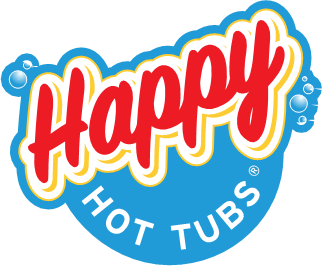
Hot Tub Water Care Guide for Beginners
A hot tub, much like a swimming pool keeps the same body of water for long periods. During these periods the water is kept safe by adding chemicals and balancing the water. There are a few different factors that come into play when looking after hot tub water and we have broken these down into the following categories:
How to Test Hot Tub Water
Testing your hot tub water is one of the more important tasks. Ensuring the test is accurate and represents a true picture of your hot tub water helps you make the correct decisions on chemical dosing. You can test in a few different ways:
- Test Strips: the easiest and cheapest way to test your hot tub water. Simply dip the strip and compare the colours to the chart on the back of the pot. Available in many different brands and suitable for bromine and chlorine users. Also great because they retrieve many different chemical readings in one quick dip.
- Visual comparators: This device works much like test strips but you add a reagent tablet to the vial and compare the colour against the chart alongside it.
- Photometers: These are great for those who struggle with the colour comparison on test strips or for those who want phone connectivity.
- Smart Water Monitors: These devices not only test your water regularly and send the data to an app on your phone but they also provide chemical dosing recommendations.
Ideal Hot Tub Chemical Levels
- Alkalinity: 80-120ppm
- Chlorine (Free Chlorine): 3-5ppm or for Bromine, Total Bromine should be 4-6ppm
- PH: 7.2-7.8
Sanitising Your Hot Tub
Your hot tub will need to be treated with a Sanitiser to control and prevent bacteria growth. Bacteria can multiply rapidly in a hot environment like a hot tub, so you must maintain an appropriate sanitiser level to ensure any bacteria in the water is killed. The main two sanitisers used in hot tubs are bromine and chlorine, however there are other sanitisers and sanitising methods.
Chlorine 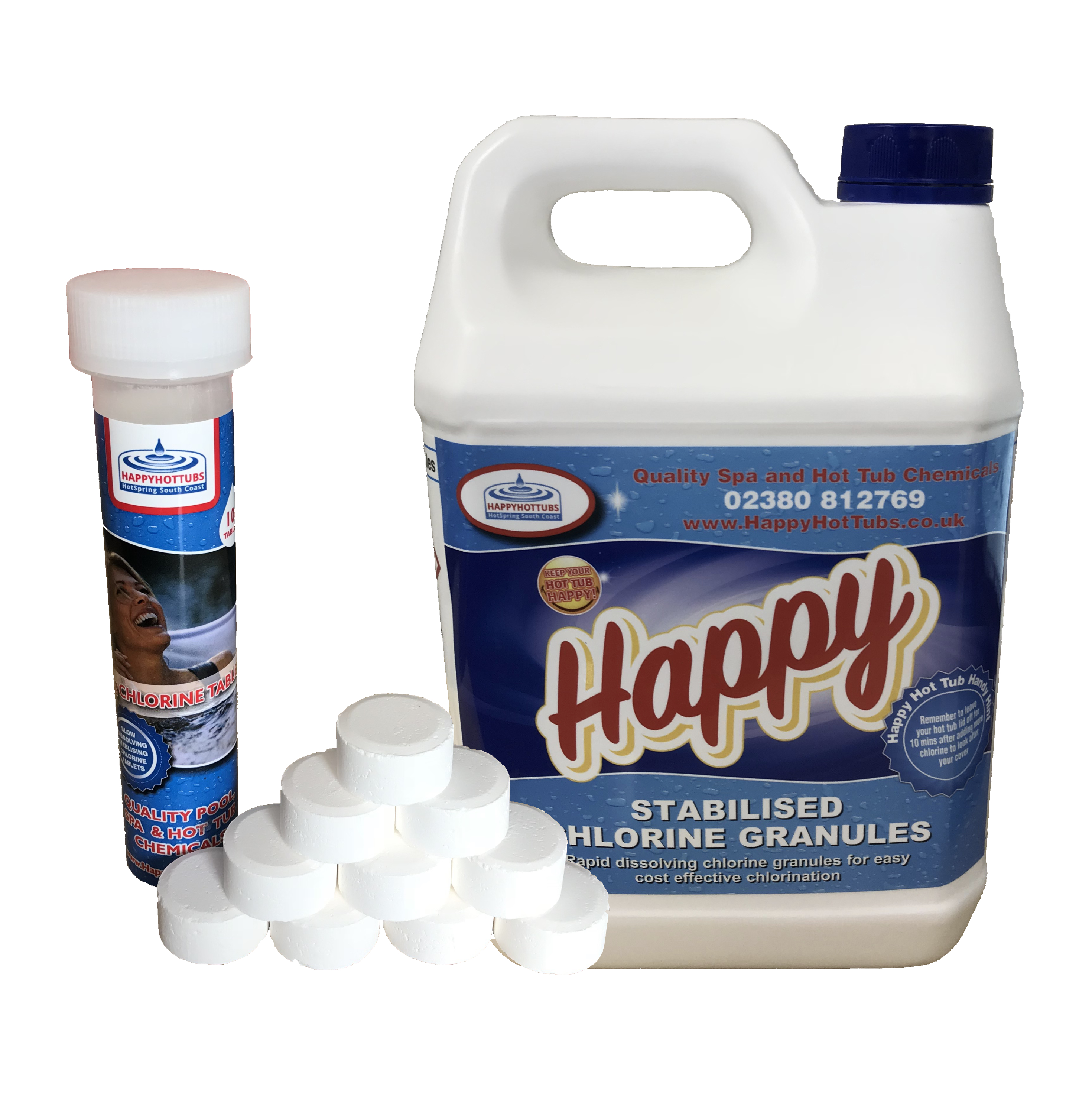
Chlorine is the most popular choice amongst hot tub users as it is the most cost effective and fast reacting sanitiser available. Chlorine is available in granules or tablets.
Chlorine granules are the sanitiser that we recommend at Happy Hot Tubs. Chlorine granules are added by sprinkling the chlorine granules over the water surface with the jets on or by pre- diluting in a container of warm water. The benefit of chlorine granules is that they are PH neutral, they are cheap and they are a good way to increase your chlorine level fast.
Chlorine tablets are slow dissolving and work by being placed in a floating dispenser, built-in feeder or filter pod. The benefit of this is that chlorine is dispensed constantly, however it does give less control than using granules. We suggest you start by adding one to two tablets and adjusting the dispenser flow/tablet amount as necessary after testing. Product Warning - Chlorine tablets are acidic and if mis-used can cause damage to your hot tub. We recommend chlorine granules over tablets.
Bromine
Bromine is an alternative sanitiser to chlorine. It is more expensive and slower reacting. Benefits include having a slightly softer smell, being much more stable in higher water temperatures and it is able to regenerate unlike chlorine (meaning you can keep reactivating 'used up' bromine). Bromine is mainly dosed in slow-dissolving tablet form through a floating dispenser, built-in feeder or filter pod. You can also purchase bromine granules to boost bromine levels when they are low.
Other Sanitisers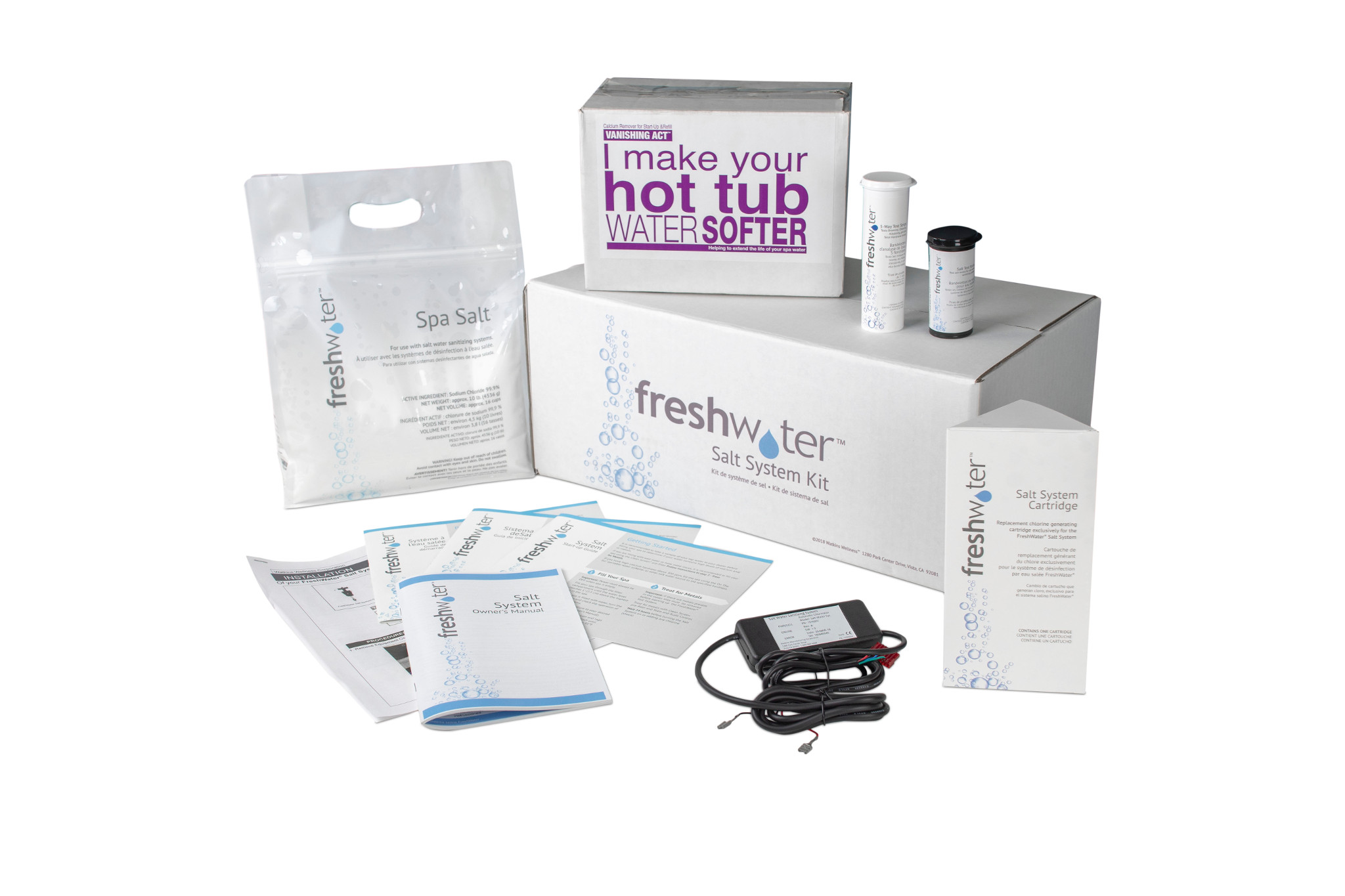
Although chlorine and bromine will be used by over 95% of hot tub users, there are alternatives available.
- Aquablanc and other O2 Systems - O2 systems use a combination of active oxygen and a sanitiser liquid (hydroxide) to keep hot tub water clean. It is worth noting that they usually require a chlorine shock on start up too. These systems are expensive and the water can be harder to keep clean vs more traditional chlorine or bromine systems.
- Salt Systems - Salt systems work by salt water passing through an electrode, which in turn produces chlorine to keep the water sanitised. These systems can be expensive and they can also bring other chemical readings such as hardness into the equation. Click here to view our full guide on the Hot Spring Freshwater Salt System
PH and Alkalinity
PH is the measure of how acidic or how alkaline your water is. 7 is the neutral PH level but in your hot tub you want to aim to get your PH between 7.2 and 7.8. If you do not balance your PH then you may be in for some nasty and potentially costly suprises including scaling, poor sanitiser efficiency and eye sting.
Total Alkalinity (TA) is the measure of the capacity of water to neutralise acids. It is different to PH. It is measured by parts per million rather than a scale like PH. Alkalinity is important as it acts as a buffer when balancing PH. If your alkalinity is out, then it will be very hard to balance your PH level. In fact it is a good idea to balance your Alkalinity before doing anything else as this may allow your PH to fall into line too and will make balancing PH much easier. Your Alklainity level should be between 80-120ppm.
Shock Treatments
In addition to whichever daily sanitiser you choose to use, it is recommended to “shock” dose or oxidise your water every week with a non-chlorine shock treatment.
Shock dosing is required to do the following:
- Break down Chloramines – sanitiser reacts with bather pollutants such as perspiration or dead skin, and produces a less effective chemical compound called chloramines which needs to be broken down. Chloramines have a strong chlorine odour that is often mistaken for too much chlorine, and make the water appear cloudy.
- Kill bacteria – some bacteria can become resistant to your sanitiser, so the shock treatment will destroy any remaining bacteria.
- Remove organic compounds – people carry organic compounds on their skin, such as dead skin and oils. These can accumulate in the hot tub and cause cloudy water, but shock treatment will remove them.
Chlorine-based Shock Treatments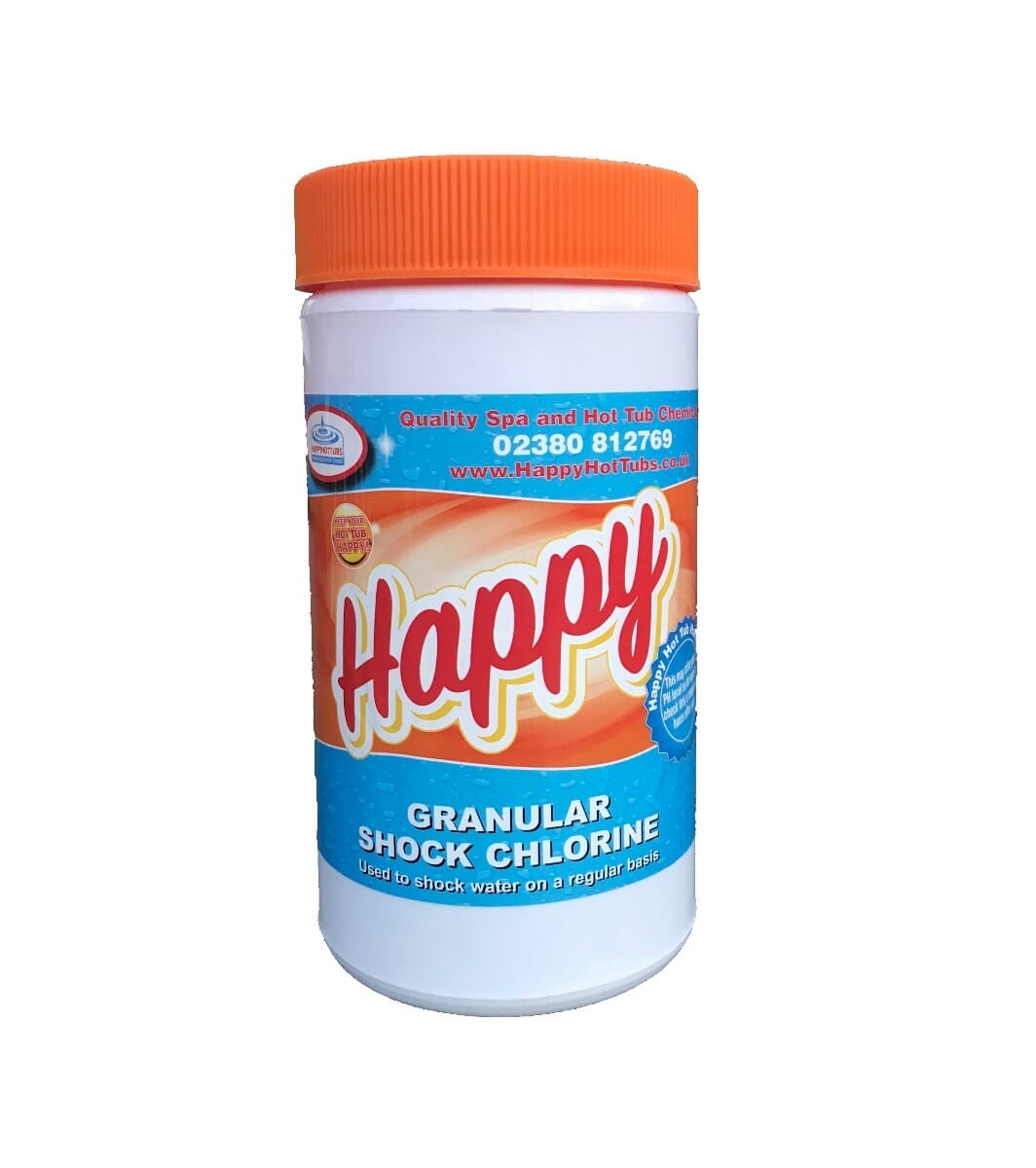
Chlorine shock treatments are chlorine-based so when used they increase your chlorine level quite significantly. The positive of this is that chlorine is very effective at what it does as a shock treatment, the downside however is that by bringing the chlorine level up high you will prevent hot tub usage for a period and also risk staining/damage to components.
Some popular chlorine-based shock treatments include Happy Shock Pot and Aquasparkle Fusion Shock Sachets.
Non Chlorine Shock Treatments
Unlike chlorine-based shock, non chlorine shock is a very effective oxidiser that does NOT affect your chlorine level. We love this chemical at Happy Hot Tubs and recommend a weekly dose to keep your water good for longer.
Read more about What is Non Chlorine Shock and What Does it Do?
Hot Tub Filter Cleaning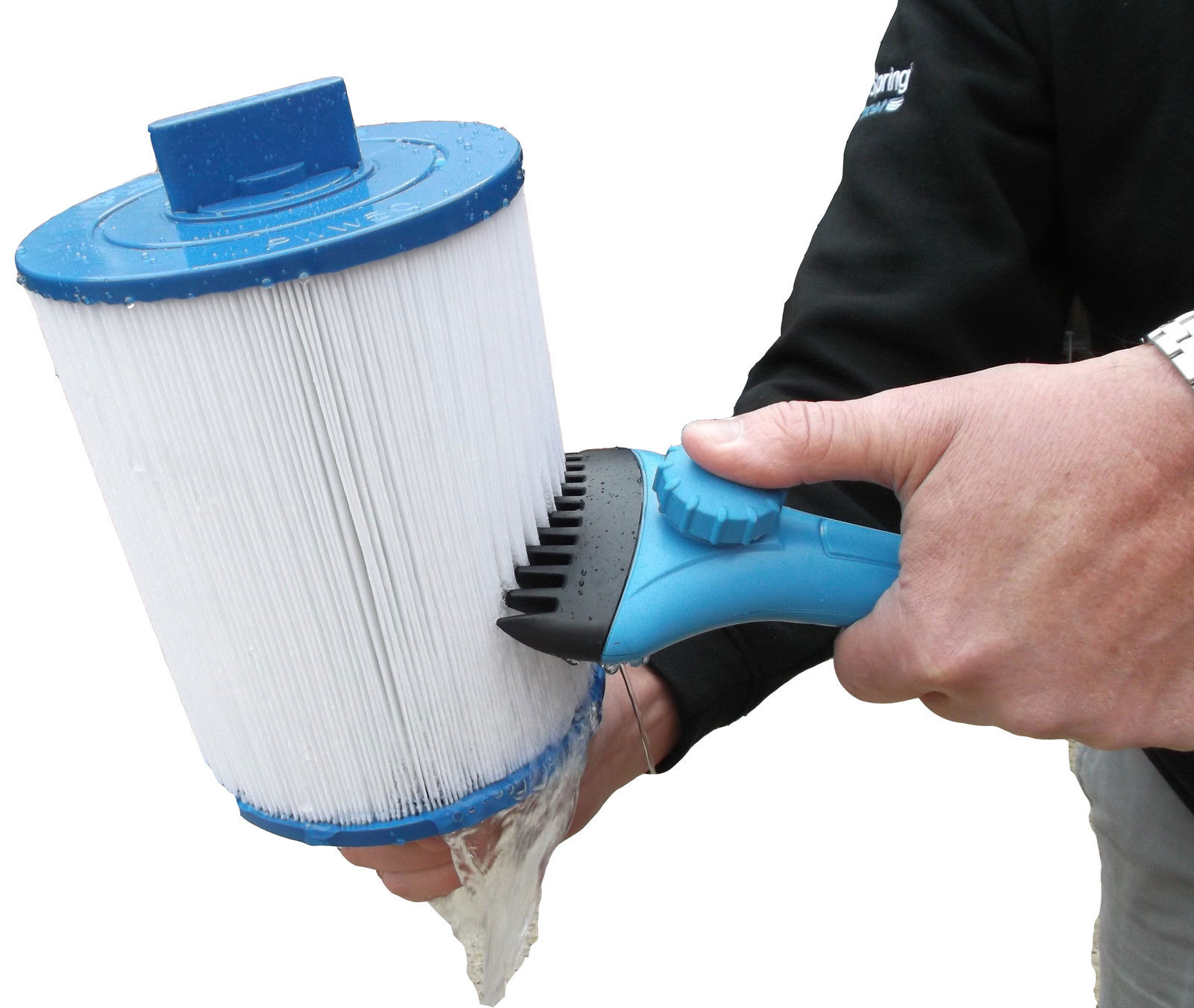
Keeping your hot tub filters clean is a very important step to keeping water safe and sanitised. With dirty filters you may also experience weaker jets, error messages and even use more energy! A hot tub filter is usually a plastic capped, paper-pleated unit that allows water to pass through as it collects oils and debris.
How often should I clean my hot tub filters?
This will depend on your usage, but we recommend you clean them with filter cleaner at least once every fortnight. When you first fill your hot tub, fill after a flush or experience heavy usage, it will be important to clean your filters more frequently.
How to Clean Hot Tub Filters
The quickest way to clean them is using Happy Instant Filter Cleaner. To do this, spray the filter evenly with the instant filter cleaner, wait 15 minutes then rinse the filter with a hose. To make rinsing easier, check out the Happy Hot Tubs Super Blaster which is a useful tool to clean multiple pleats at once!
Another way to clean your filters is to soak them in a bucket overnight with Happy Filter Cleaner solution. This solution breaks down oils from the pleats and gives the filter a deep clean. With both of these techniques, it is recommended to allow the filter to dry as this resets the fibres in the filter media, making filtration more effective when the filter is put back into your hot tub.
How often should I replace my hot tub filters?
Filters can become worn over time and the filter media may start breaking up. At this point they will need replacing. We recommend replacing every 2-3 years depending on the filter you have and how well they have been looked after.
Water Changing (Flush, Drain and Re-fill)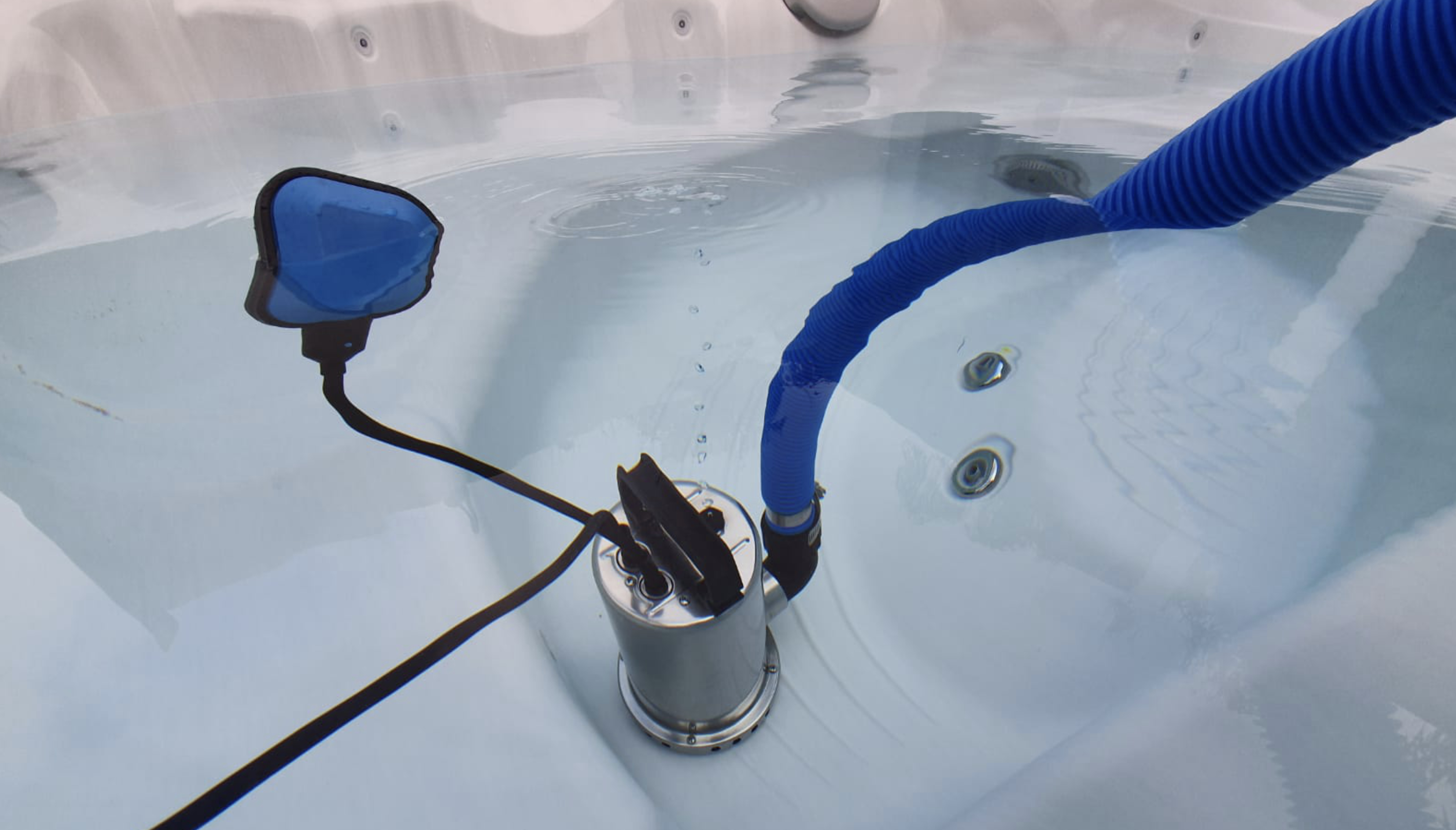
Hot tub water can only be chemically maintained for so long before it becomes saturated and it needs replacing. We recommend changing your water every 3 to 4 months depending on usage.
We suggest that you use a hot tub flush/pipe cleaner prior to emptying the hot tub. This will remove any dirt/debris and loosen any calcium from the pipe work, which will then be washed away with the drained water.
Read more about How To Flush, Drain and Re-fill a Hot Tub
Want us to service your hot tub for you? See our hot tub service and service plan offering
Other Water Chemicals
If you follow the principles outlined above you should not need to purchase lots of other hot tub chemicals. We offer a wide range of products to help in specific situations and have broken down a few of these here:
- Happy No Foam – This product will reduce the tendency of the spa water to foam, but it will not always stop it entirely. Foam is created as a reaction to natural oils in our skin, as well as contaminants such as remnants of detergents in swimwear, cosmetics and deodorants, etc. Showering with your swimwear on before entering the water will help reduce foam. This anit-foam product temporarily suppresses foaming but will not remove the cause. Find out more about cloudy, milky or foamy hot tub water.
- Happy Spa Sparkle – If your levels are fine but your water is cloudy then Spa Sparkle will help bring back the clarity. It is a coagulant, which means it will gather small particles in the water together so they are caught in the filters.
- Happy No Scale – This product is used in hard water areas to prevent the calcium build up to form scale on the spa equipment and fittings. It is also used to break down and remove scaling after it occurs. It is important to note that limescale forming in hot tubs is caused by imbalanced PH.
- Water conditioners - Advanced water conditioners like O-Care and Silk Balance offer great benefits to hot tub water including softening, locking in your PH and reducing sanitiser usage. These products are added weekly to the water.
Hot Tub Cover Care
We have included cover care in this guide as it is an important part of hot tub maintenance. Hot tub covers can be directly impacted by poor water chemistry and therefore there is a key link between water care and the lifepsan of your cover. We recommend cleaning your cover every month if possible and applying cover protectant every 4 months, which helps protect your cover from UV and other debris.
Video Guide
In the below video, we explain how to maintain hot tub water using our Happy Chlorine Starter Kit, which contains many of the aspects and items mentioned above.
Water Care Schedule
To try and make your hot tub water care nice and easy we have broken down what we would recommend doing in our schedule table. Please note that individual cirumstances mean that this is not a complete guide for all hot tub owners but something to use as a base for your hot tub maintenance routine.
Frequency |
Action |
|
Daily (or every 2-3 days with light usage) |
Ensure chemicals are balanced. Adjust water with chemicals if necessary. |
|
Weekly |
Rinse filters to remove large debris. |
|
Fortnightly |
Clean filters with filter cleaner to de-grease them. |
|
Every 4 Months |
Flush, drain and re-fill your hot tub with fresh water. Apply protectant to cover. |
|
Yearly |
Consider an Annual Service to check components |
|
Every 2-3 Years |
Replace hot tub filters. |
